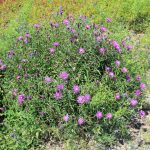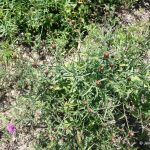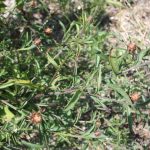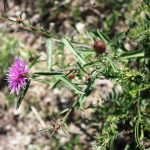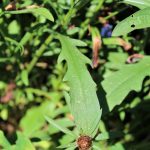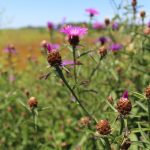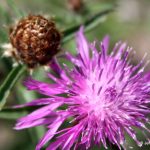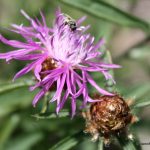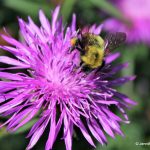Knapweed
Prepared by Jennifer L. D’Appollonio, Assistant Scientist, University of Maine, Orono, ME 04469. Updated April 2019.
Scientific name: Centaurea L. (Centaurea nigra L. / Centaurea jacea L.)
Common name(s): Knapweed (lesser knapweed, black knapweed / brown knapweed, brownray knapweed)
Links: C. nigra USDA PLANTS Profile, Go Botany; C. jacea USDA PLANTS Profile, Go Botany
Images: (to see enlargements [PC]: click on image, then right click and choose “view image”)
- mature plant in wild blueberry field
- Early July
- leaves may be hairy, but not spiny
- leaf detail
- flowers and bracts
- flowers are thistle-like
Description:
-perennial
-can grow up to 5 feet tall
-basal leaves and stem leaves
- lobed/toothed
-black bracts
-spreads by seeds and rhizomes
–C. nigra and C. jacea hybridize in New England and may also be confused with each other. See left sidebar of Go Botany webpages, above, for more information.
Habitat:
-disturbed areas
-meadows and fields
-cultivated fields
Natural History:
-native to Europe and Russia
Management:
-hand pull and remove the entire tap root
-mow or cut plants before flowering
-Herbicide treatments are most effective when combines with other control techniques
-3% solution of triclopyr herbicide mixed with water can be applied to leaves in early spring or fall
-Gall flies are used to feed on developing seed heads.
Source(s):
Haines, A., Farnsworth, E., Morrison, G., & New England Wild Flower Society. (2011). New England Wildflower Society’s Flora Novae Angliae: A manual for the identification of native and naturalized higher vascular plants of New England. Framingham, MA: New England Wild Flower Society. p. 387.
Go Botany. “Centaurea Nigra L.” Centaurea Nigra (Black Knapweed): Go Botany, 2020, gobotany.nativeplanttrust.org/species/centaurea/nigra/.
Michigan State Universiy. “Black Knapweed (Centaurea Nigra).” Midwest Invasive Species Infomation Network, 2020, www.misin.msu.edu/facts/detail/?project=misin&id=295&cname=Black+knapweed.

